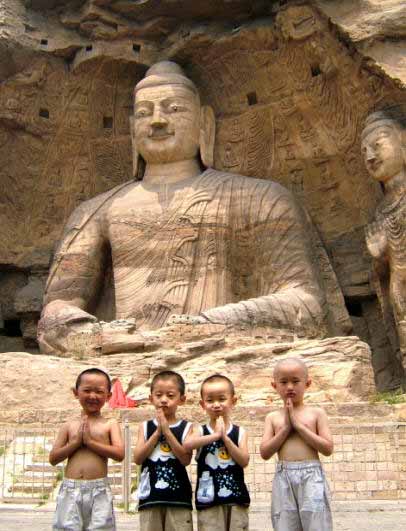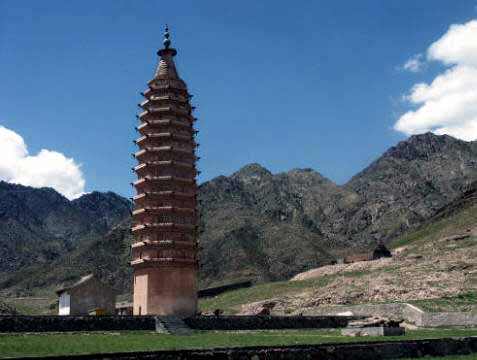Star Date: September 2005
China: Beijing & Beyond
Hello Dear Family & Friends!
Nihao!
(Greeting – Mandarin)

(May Joseph & Nancy travel with Dragon Luck through China)
" I was walking along a little road through a hilly landscape; the sun was shining and I had a wide view in all directions. I came to a small wayside chapel. The door was ajar. There were flowers on the altar. I then saw that on the floor in front of the alter, facing me, sat a yogi -in lotus posture, in deep meditation. When I looked at him more closely, I realized that he had my face. I started in profound fright, and awoke with the thought, 'Aha, so he is the one who is meditating me. He has a dream and I am it.'
(Carl Jung – ‘Chuang-tzu of the west’ )

A very proud, rural Chinese couple, at the Forbidden City.
The Dragon IS Awakening!! With all the changes catapulting China into the 21st century there is no doubt that we will be seeing and hearing more of this once Sleeping Giant in the future. The world’s oldest surviving civilization had its doors closed to foreigners, for the most part, until the late 1970’s. China has woven its way through over 6000 years of emperors, dynasties and sieges producing majestic man made wonders such as the Great Wall and the Terracotta Warriors. Ingenious inventions such as paper, printing, gunpowder, porcelain, silk, noodles and the compass originated in China and then spread to other parts of the world. Did I mention toilet paper (too bad clean toilets in some places weren’t on the list)? With only 55 years under communist rule Mao Zedong and his successors had the task of unifying almost 1.5 billion people. Aside from the horrific damage caused by the 10 year Cultural Revolution of the 70’s, the now apparent results of the one child decree has allowed China’s controlled population to embrace more western ways and willingly venture into capitalism. With sadness we ask, “Is this jump into materialism only marking a decline in this magnificent civilization and opening a Pandora’s Box?” Historically the Chinese have been shrewd and adept businessmen. This fact compounded by the insatiable desire by westerners to have a plethora of cheap manufactured goods to line our store shelves is devastating the culture and environment of China. Willing buyer, willing seller. Welcome to the 21st century China!

The Terracotta Warriors in Xi’an.
Xi’an is an example of the richness of China’s past. The western terminus for the caravans on the Silk Road, Xi’an was already a classic world city 2 centuries before Homer wrote the Illiad and the Odyssey, 5 centuries before Buddha’s enlightenment, and how many centuries before the inception of the “new kid on the block”, United States? Surrounded by a 6 km long, 60 ft high Ming Dynasty Wall, the blending of Buddhist temples, Islamic mosques, and narrow streets with market places in the shadows of skyscrapers, shows this city’s extraordinary ability to change with the times. The 2000 year old Army of Terracotta Warriors stands guard nearby with over 6000 life size figures, each with a unique face. A beehive of activity this is one of those archeological places you just have to see.

Within the ancient walls of Pinyao.
An overnight train ride away we stepped back in time to the 800 BC walled city that time forgot, Pinyao. One of our favorites to date this impoverished, ancient little town was undiscovered until a few years ago. Aside from several market lined streets, that cater to a few busloads of tourists daily, this village is a living example of the old days at every turn. We stayed in a family owned guesthouse that was “only 350 years new” (#29, next to the central Bell Tower). In typical style it had an elaborately carved Ming gate and peaceful tree filled inner courtyard. The room had an 8 x 6 foot brick lined bed which is filled with warm coals on a cold winter’s night. Boasting one of the only private bathrooms it was complete with a phantom hand dryer that randomly blared, no hands in site, in hilarious contrast of old meets new! Pinyao boasts the 18th century establishment of the first Qing Dynasty bank in existence, with a system of credits and debit checks set up for 56 of a dye company’s remote offices. Do you think these insightful businessmen would roll over if they saw how many modern people live only on credit? I can see the abacuses whirling now!

Mao still stands guard over the entrance to the Forbidden City in Beijing.
Beijing, the “Fire in the Belly of the Dragon”, has been the governmental center of China for centuries. Peking was annihilated by Genghis Khan, bragged about by Marco Polo, reshaped by the Ming Dynasty, and plunged into chaos by the Cultural Revolution. Currently being “spit polished” for the 2008 Olympics, expansion is non stop. Gone forever since my 1999 visit are the gobs of spit everywhere; the quirky “Chinglish” signs much to the dismay of my twisted humorous mind (such as in a bank: “Question Authority” i.e. talk to the teller, or proudly displayed outside one of our hotels “ Define Entertainment Character Esoteric Repast” i.e. anyone’s guess???); pet shop-like cages of dogs, cats, snakes, etc of potential delicacies out front of large restaurants; and simple markets or specialized shops being replaced by department stores full of Chinese produced products that no one really needs. And did I mention a McDonalds, KFC, or Starbucks on every major corner??? We preferred to buy our fruit and veggies from the local markets and eat at a small buffet style “hole in the wall” in our hutong for 3 Yuan each or 30 cents, including rice. The locals loved us and we didn’t see another westerner in there in 4 days. We chose to stay at a small local hotel, near Tiananmen Square (close to the Far East Hostel) down a hutong, or narrow alleyway, teeming with everyday Chinese life.

A delicate Chinese flower in Ming Dynasty dress.
Walking across Tiananmen Square, the world’s largest public square, symbolically the center of the Chinese Universe, we passed thousands standing under the scorching sun to see a glimpse of “Pickled Mao” and the historic monument where anti government student protesters were slaughtered in 1989. Up to a million people have gathered here at one time so no bicycles are allowed, only an occasional tank I guess, and closed circuit television cameras and plain clothed policemen ensure that any fire of dissent is quickly extinguished. The people are still closely monitored by the government but with international contact and exposure things are definitely loosening up. When entering the US as a foreigner, even transiting, under Homeland Security you are required to give fingerprints plus visa and photos. This is not the case in China. Is China relaxing and the US losing more freedoms? Human rights issues and the environment in China will also improve because of pressure from business with the international community. Our hats off to the progress in the New China!

Joseph hiking the Great Wall at Simatai. It actually follows along even the distant mountain tops before it disappears.

Little Budding Buddhas at Cloud Ridge Caves near Datong.

The 14 storey Baisikou Pagodas.
“He who has not climbed the Great Wall is not a true man.” (Mao Zedong) I guess we are true men because we chose to avoid the tourist circus at Badaling and bussed 110 km out to Simatai. Arriving into the parking lot and not seeing a single tour bus made it all worthwhile. Not for the faint of heart this rough 19km section of the wall, perched on mountaintops is very steep. With a 70 degree incline in places you have to actually scramble up in spots. Climbing up, then walking the wall for several kms. we rejoiced in our first crystal clear, pollution free day for some time. The views of the wall snaking along the mountains and valleys were absolutely breathtaking. On the way down we heard a scream and caught a glimpse of someone flying down along a 1/3 mile long wire from the wall to the lake below. Too good to pass up Joseph and I became birds and tried out the scary but easy way to get down. A boat ride across the lake put us back where we started, exhilarated and ready for the next adventure!

Enchanting and mischievous 86 yr old Taoist
temple painter, in Gunzhongkou.
From the throngs of Beijing we headed 7 hours west by train to Datong. Even if you aren’t interested in ancient archeological sites, like we are, you cannot go away from the Cloud Ridge Caves “unwowed”. Located next to the pass leading to Inner Mongolia these caves, that stretch for about 1 km., contain over 50,000 Buddhist statues, the largest being over 30 meters/ ninety feet tall (now the 2nd tallest in the world). About 75 km SW of Datong the 1400 year old Hanging Monastery is perched precariously on the sheer cliffs above Jinlong Canyon. One can only imagine what a peaceful existence the handful of reclusive monks had before the government turned this monastery into a tourist attraction. Luckily not all the country’s ancient relics were destroyed by the Cultural Revolution because the Chinese government has discovered that rather than “Religion is Poison” it is also worth big bucks from tourists.

A small Buddhist courtyard, with ceremony, in the Helan (Shan) Mountains.

